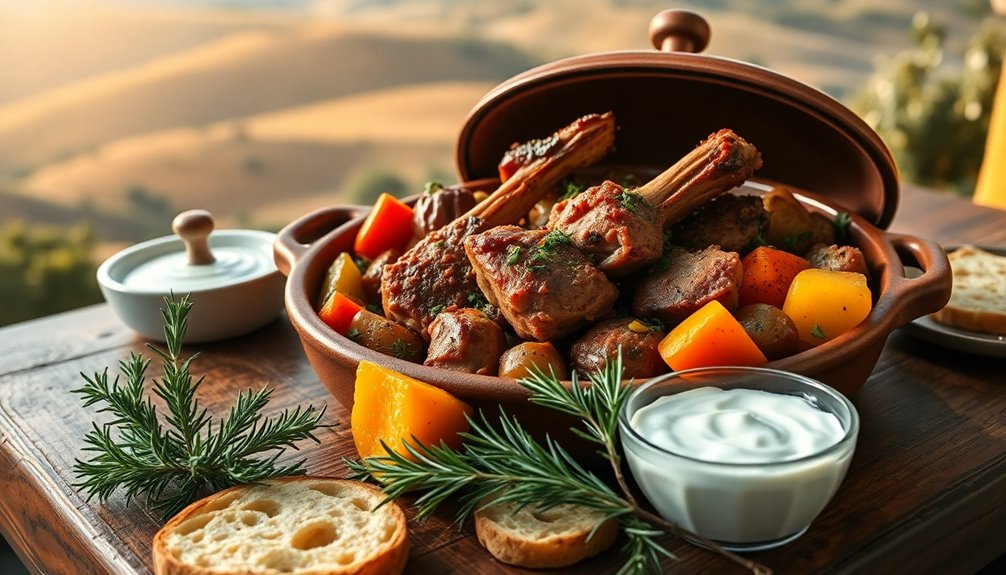Kleftiko with pork brings a delicious twist to the classic Greek dish. You'll marinate tender pork with fresh vegetables like potatoes and bell peppers, then wrap everything in parchment for baking. This method locks in moisture and flavor, making each bite juicy and satisfying. After cooking, the golden finish is perfect for sharing. Want to know more about the origins, cooking tips, or enhancing your Kleftiko experience? There's plenty more to explore!
History
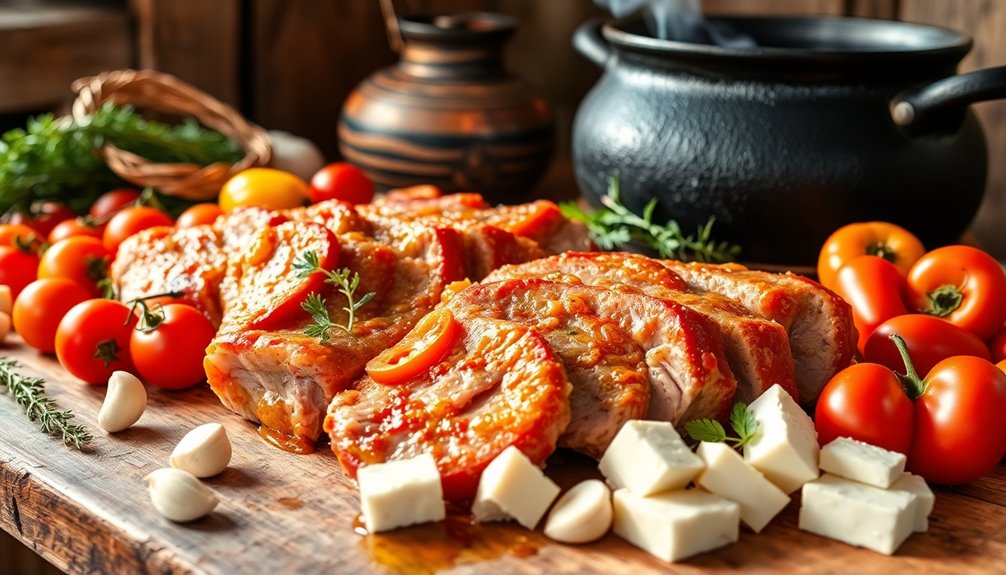
Kleftiko has a fascinating history that dates back to ancient Greece, where it was a dish born out of necessity and stealth.
Originally, this Greek dish was crafted by outlaws, who'd steal lamb and bury it with hot coals, allowing it to slow-cook underground. The term "Kleftiko" derives from "kleftes," meaning "thieves," a nod to its origins among bandits.
Kleftiko, a dish with roots in ancient Greece, was originally crafted by outlaws who slow-cooked stolen lamb underground.
While lamb remains the traditional meat, variations using pork, chicken, or beef have emerged, showcasing the dish's adaptability.
Today, modern Kleftiko often involves marinating the meat with herbs and spices, wrapping it in parchment or foil to enhance moisture and flavor. This evolution reflects the rich cultural tapestry of Greece, making Kleftiko a beloved choice for gatherings and special occasions, much like the importance of support systems in navigating life's transitions.
Recipe

Preparing Kleftiko is straightforward, yet the results are truly impressive. The key is to allow the pork to marinate adequately, which enhances the taste and tenderness.
Once cooked, the dish is served directly in the parchment pouches, allowing guests to experience the joy of unveiling their individual servings. This not only adds an element of surprise but also keeps the dish hot and fresh until it's time to eat.
Ingredients:
- 1 kg fattier pork cuts (e.g., shoulder or belly)
- 4 tablespoons olive oil
- Juice of 2 lemons
- 4 cloves garlic, minced
- 2 teaspoons dried oregano
- Salt and pepper to taste
- 4 medium potatoes, peeled and cut into wedges
- 2 onions, sliced
- 2 bell peppers (any color), sliced
- Parchment paper
Cooking Instructions:
Begin by marinating the pork in a mixture of olive oil, lemon juice, minced garlic, oregano, salt, and pepper for 1-2 hours in the refrigerator.
Once marinated, preheat your oven to 180°C (356°F). Lay out large pieces of parchment paper and place a portion of the marinated pork in the center, followed by an assortment of the prepared vegetables.
Fold the parchment over the contents to create sealed pouches, ensuring no steam escapes during baking. Place the pouches on a baking tray and bake for about 85-90 minutes, or until the pork is tender and fully cooked.
Extra Tips:
For best results, choose pork cuts that have a good amount of fat, as this will keep the meat moist during cooking.
Feel free to customize the vegetables based on your preference or seasonal availability; zucchini and carrots also work well.
Additionally, consider serving the Kleftiko with a side of olives and a fresh Greek salad to enhance the meal's Mediterranean flair.
If you want to add a smoky flavor, try grilling the vegetables for a few minutes before wrapping them in parchment. Smart toilets can also offer enhanced hygiene and comfort, making the dining experience even more enjoyable.
Cooking Steps
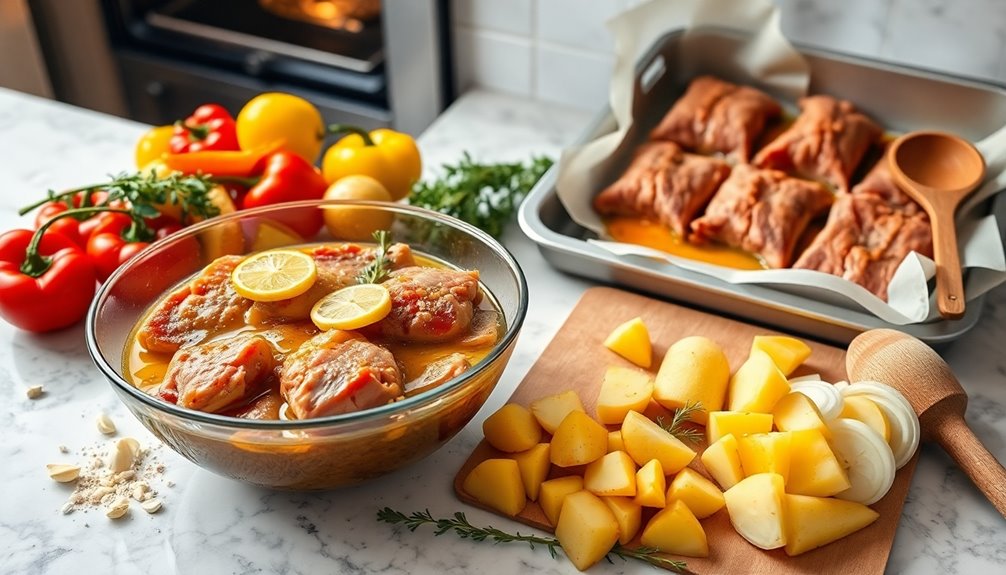
To kick off your cooking process, preheat your oven to 350°F.
Next, chop your vegetables into bite-sized pieces and mix them with the marinated pork.
Season everything with your favorite herbs and spices before wrapping it all up in parchment paper for a flavorful bake. Incorporating fermented vegetables can add an extra layer of flavor and enhance the dish's nutritional value.
Step 1. Preheat Oven to 350°F

Preheating your oven to 350°F (180°C) is essential for achieving perfectly cooked pork kleftiko. A preheated oven ensures even cooking and optimal flavor release, making a noticeable difference in your dish.
Before placing your pork inside, wait until the oven reaches the desired temperature; this helps prevent uneven cooking. For slow cooking, aim for about 85-90 minutes in the oven, allowing the flavors to meld beautifully while the meat becomes tender.
To ensure safety, use a thermometer to check that the internal temperature of the pork reaches at least 145°F (63°C). If you want a crispy finish, consider increasing the temperature to 400°F (200°C) for the last 15-20 minutes of baking. Additionally, color accuracy plays a significant role in enhancing the visual appeal of your dish when served.
Step 2. Chop Vegetables Into Bite-Sized Pieces
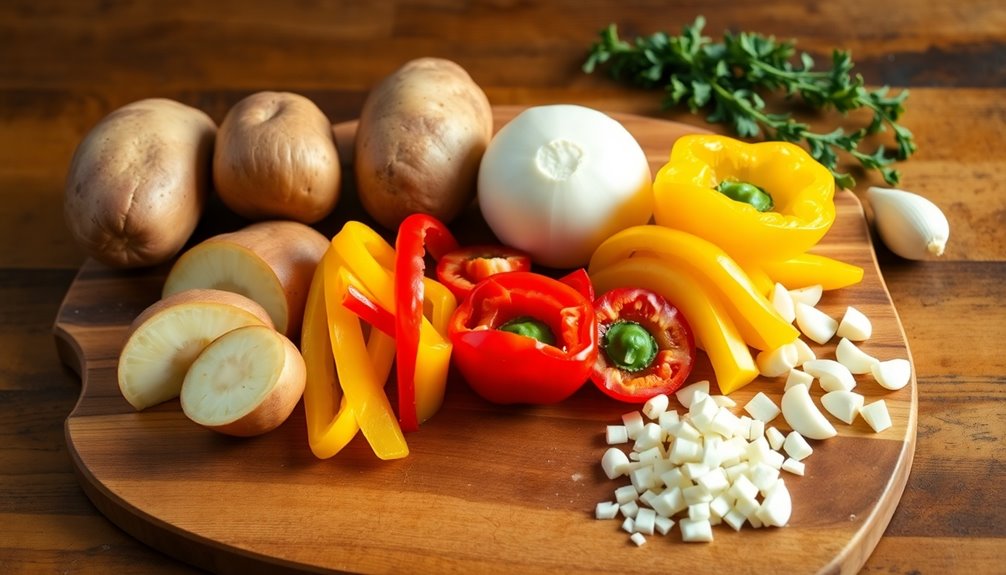
While chopping vegetables for your Kleftiko with pork, make sure to cut them into uniform bite-sized pieces, around 2-3 cm. This size promotes even cooking and ensures a consistent texture throughout your dish.
Use a mix of colorful bell peppers, onions, and tomatoes to enhance both the visual appeal and flavor profile. For potatoes, slice them into wedges or rounds; this helps them absorb the olive oil and the flavors of your marinade effectively.
Don't forget to wash and peel root vegetables like carrots or parsnips before chopping, as this keeps everything clean and tastier.
To elevate the dish, incorporate garlic by mincing or slicing it thinly, allowing its flavor to infuse beautifully with the pork and vegetables. Additionally, including a balance of protein, fiber, and healthy fats in your meal can contribute to a more satisfying and nutritious dining experience.
Step 3. Add Pork to Vegetable Mix
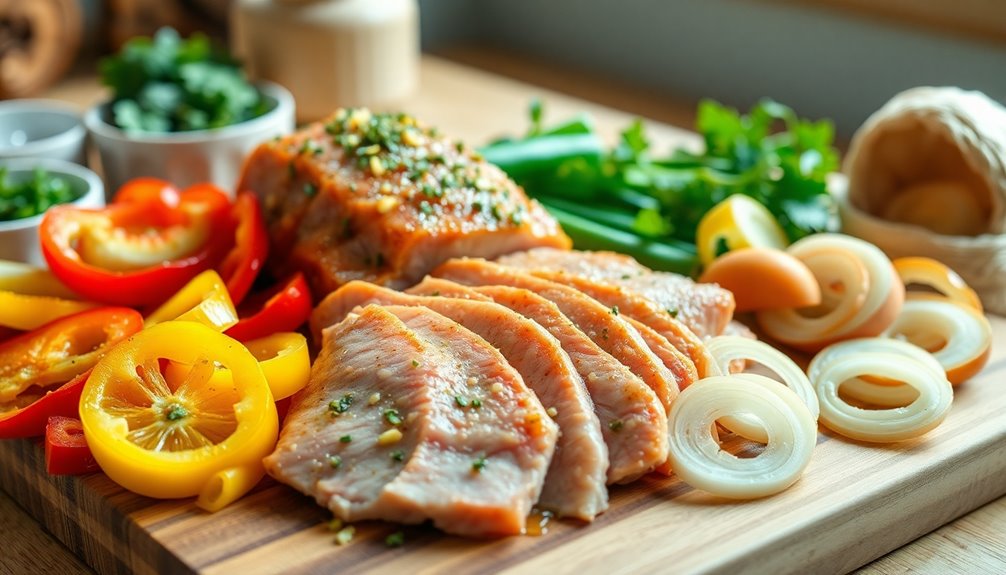
Once you've chopped the vegetables and marinated the pork, it's time to combine them for a burst of flavor.
Start by cutting the pork into 2×2 cm cubes, ensuring they cook evenly alongside the vegetable mix. In a large bowl, mix the marinated pork with roughly chopped onions, bell peppers, and minced garlic. This combination creates a vibrant and tasty vegetable blend.
For cooking, layer the vegetable mix in parchment paper pouches to lock in moisture and enhance flavors. If you like, add sliced tomatoes on top of the pork and vegetables before sealing the pouches.
Finally, bake the sealed pouches in a preheated oven at 180°C for about 85-90 minutes, allowing the pork to soak up all those delicious vegetable flavors. This method of cooking is similar to making Dirt Cups where layering enhances the overall taste experience.
Step 4. Season With Herbs and Spices
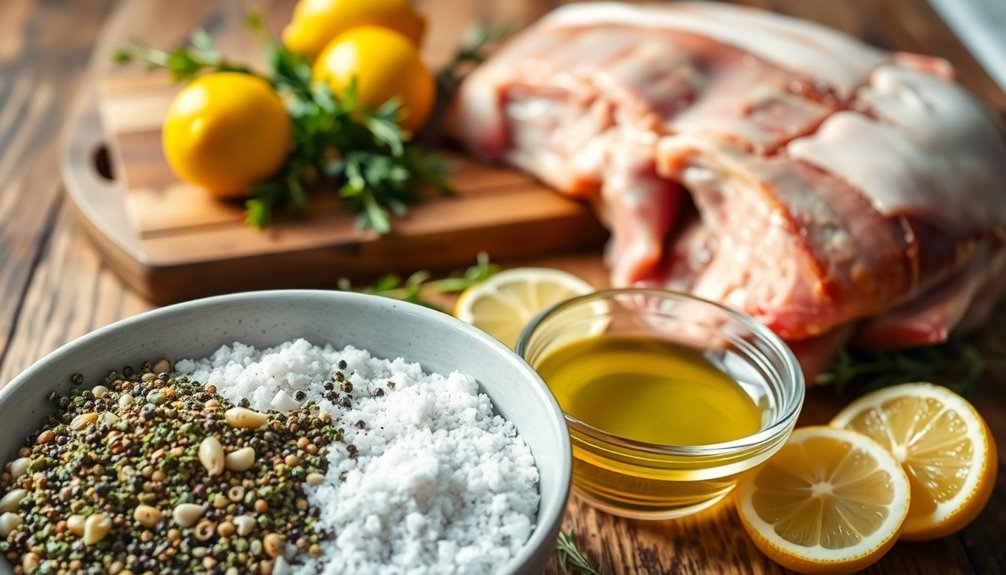
To elevate the flavor of your Kleftiko, season the marinated pork generously with a blend of herbs and spices.
Start by adding a good amount of fresh or dried oregano and salt to enhance the traditional Greek flavor profile. The lemon juice from your marinade will provide a bright tang that pairs perfectly with these seasonings.
Don't forget to mix in minced garlic and chopped onions, as they add depth and savory notes.
For an extra touch, consider tossing in a couple of bay leaves and a splash of white wine, which won't only complement the herbs but also help tenderize the meat during cooking. Additionally, using essential oils like rosemary oil can enhance the overall flavor and aroma of your dish.
Let the pork soak up these flavors for the best results!
Step 5. Wrap in Parchment Paper
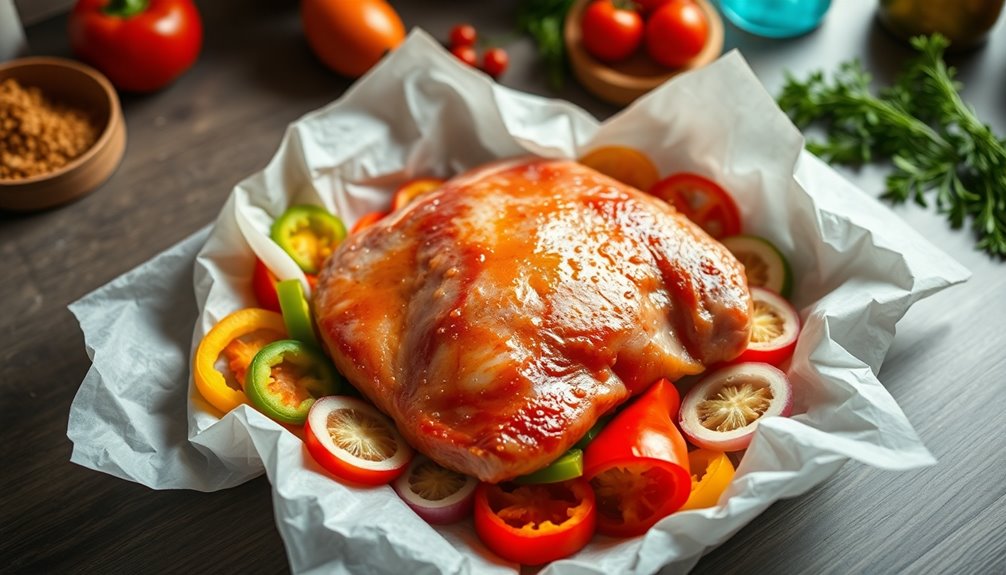
Before you start wrapping your Kleftiko, prepare the marinated pork by cutting it into 2×2 cm cubes.
Next, cut 4-6 pieces of parchment paper, large enough to securely enclose the pork and vegetables.
Place a layer of diced potatoes on each parchment sheet, followed by the marinated pork cubes.
Add sliced tomatoes and any additional vegetables you like.
Now, wrap the parchment paper tightly around the ingredients, ensuring no gaps for steam to escape during cooking.
Once wrapped, bake the pouches in a preheated oven at 200 degrees C for about 1 hour.
To achieve that golden finish, open the parchment for an additional 20 minutes.
Enjoy your delicious Kleftiko recipe! Including a side of corn on the cob will add a delightful contrast to your meal.
Final Thoughts
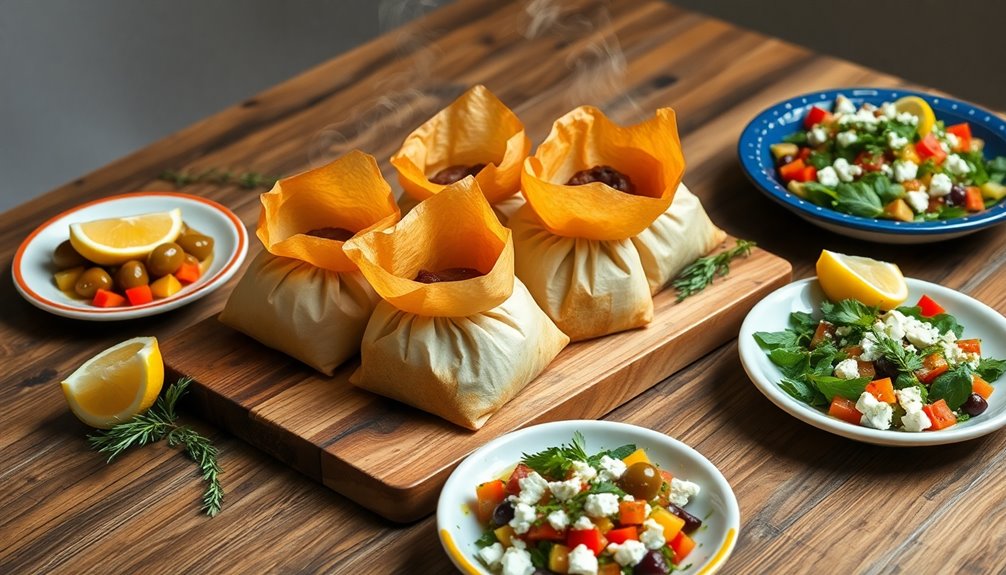
While enjoying Kleftiko with pork, you'll discover a dish that not only tantalizes the taste buds but also brings a sense of warmth and togetherness to any gathering.
This classic Greek meal, known for its slow-cooked perfection, is a real crowd-pleaser. The marinated pork, combined with fresh vegetables like potatoes, onions, and bell peppers, creates a flavorful experience that's hard to resist.
The unique cooking method, sealing everything in greaseproof paper, ensures the meat remains moist and tender. When you serve this visually appealing dish, it encourages sharing and connection among diners. Additionally, exploring global flavors can elevate your culinary repertoire and inspire new creations in your kitchen.
Frequently Asked Questions
What Meat to Use for Kleftiko?
When you're deciding what meat to use for Kleftiko, consider traditional lamb for its rich flavor and tenderness.
However, if you want to switch things up, pork can be an excellent alternative. Fattier cuts like pork shoulder or belly work best, as they stay moist during cooking.
Just remember to cut the meat into 2×2 cm cubes for even cooking and optimal flavor absorption from the marinade.
Enjoy experimenting with both options!
Are Gyros in Greece Made With Pork?
Oh sure, because who wouldn't want to know if gyros in Greece are made with pork?
Spoiler alert: they are! In fact, pork is often the star of the show, especially in places like the Peloponnese.
It's marinated in a delightful mix of spices, then cooked to perfection on a vertical rotisserie.
Served in a pita with all the fixings, it's a must-try street food.
What Does the Greek Word Kleftiko Mean?
The Greek word "Kleftiko" means "stolen." This term reflects the historical connection of the dish to bandits who secretly cooked meat.
You'll find that Kleftiko embodies resourcefulness, often linked to the Greek War of Independence. Traditionally, it involves marinating meat and vegetables, wrapping them, and cooking them underground to preserve their flavors.
This unique method not only creates tender meat but also symbolizes the cleverness of those who prepared it.
Can You Cook Pork With Lamb?
Yes, you can cook pork with lamb! They complement each other well due to their rich flavors and textures.
Just make sure to adjust cooking times since pork typically cooks faster. Keep an eye on the internal temperatures; pork should reach at least 145°F (63°C), while lamb can be cooked to your preference.
With the right seasoning and marinades, you'll create a deliciously juicy and flavorful dish that everyone will enjoy!
Conclusion
In the end, kleftiko with pork is a dish that brings together history and flavor in a way that feels as timeless as your grandma's old cookbook. You've mastered a recipe that transports you straight to a sun-soaked Greek island, even if you're just enjoying it on your couch while scrolling through your favorite social media feed. So, grab a fork and dig in—this delicious meal is sure to impress, making you the culinary hero of your next gathering!
